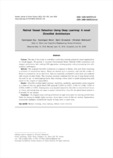

PARTNER
검증된 파트너 제휴사 자료
Retinal Vessel Detection Using Deep Learning: A novel DirectNet Architecture
방대한 850만건의 자료 중 주제별로 만들수 있는 최적의 산출물을 해피 캠퍼스에서 체험 하세요 전문가의 지식과 인사이트를 활용하여 쉽고 폭넓게 이해하고 적용할수 있는 기회를 놓치지 마세요
9 페이지
최초등록일 2023.04.05
최종저작일
2018.06

-
 * 본 문서는 배포용으로 복사 및 편집이 불가합니다.
* 본 문서는 배포용으로 복사 및 편집이 불가합니다.
미리보기
서지정보
· 발행기관 : 대한시과학회
· 수록지 정보 : 대한시과학회지 / 20권 / 2호
· 저자명 : Hyeongsuk Ryu, Hyeongjun Moon, Björn Browatzki, Christian Wallraven
목차
Abstract
Ⅰ. Introduction
Ⅱ. Methods
Ⅲ. Results
Ⅳ. Conclusion
References
요 약초록
목적: 본 연구는 망막 영상의 혈관 분할을 위한 새로운 심층 인공 학습 시스템을 구축하는데 목적이 있 다. 기존 CNN (Convolutional Neural Network) 아키텍처를 제시하고, CNN 방식을 토대로 성능을 개선한 DirectNet을 고안하는데 있다. 특히, 기존 CNN에 비해 처리 시간을 크게 단축시키는데 있다.
방법: 제안된 DirectNet 아키텍처는 피라미드 형식의 블록(Block)들로 구성되며 각 블록은 컨볼루션레이 어 (Convolution layer) 묶음을 포함한다. 하나의 블록은 학습 결과를 보존(저장)하는 단위이다. 블록들은 순차적으로 하나씩 증가하며 피라미드 형식으로 쌓이게 되고 이를 통해 초기 학습 결과가 소멸되지 않고 최종 분석에 활용될 수 있도록 하였다. DirectNet은 패치(Patch) 추출과 Pooling 과정 없이 이미지를 학습하여 학습 층을 거듭하여도 원본 이미지와 동일하게 유지되는 것이 특징이다. 또한 다양한 커널사이즈를 활용 하되 Depthwise Separable Convolution(DSC)을 활용하여 색을 구성하는 RGB(Red, Green, Blue)픽셀로 부터 혈관 모양을 인식 및 탐지한다.
결과: DirectNet은 최첨단 패치 기반 CNN 접근 방식 (0.9538 vs 0.9327, 0.7851 vs 0.7346, 0.9782 vs 0.9730, 0.8458 vs 0.7987)과 비교하여 더 높은 정확도, 감도, 특이도 및 정밀도 값을 제공하였다. Direct Net의 학습 시간은 8시간에서 1시간, 테스트에 소요된 시간은 1시간에서 이미지 당 6초로 크게 단축하였다.
결론: 제안 된 심층 학습 아키텍처는 기존의 CNN 방식으로 진행한 학습 시간에 비해 8배, 테스트에서 600배 빠른 속도로 결과를 제공한다. DirectNet은 CNN에 비해 2.11%의 약간 높은 정확도를 보였으며, 다 른 측정 항목에서도 동등하거나 그 이상의 결과를 보여 분석 시간 효율을 크게 높였다.영어초록
Purpose : The aim of this study is to develop a novel deep learning system for vessel segmentation of retinal images. We present a recurrent Convolutional Neural Network (CNN) architecture and compare performance with existing CNN approaches, showing greatly reduced processing time with excellent performance.
Methods : The proposed DirectNet architecture is composed of blocks, with each block containing a collection of convolutional layers. Blocks are stacked up in a pyramid, such that the number of blocks is increased by one at each level. Data are repeatedly processed by each block and combined with outputs of other blocks. This recurrent structure combined with the use of large kernel avoids the need for up- or downsampling layers, thus creating a direct pixel-to-pixel mapping from pixel inputs to the outputs of segmentation.
Results : DirectNet provides higher accuracy, sensitivity, specificity, and precision values compared to a state-of-the-art, patch-based CNN approach (0.9538 vs 0.9327, 0.7851 vs 0.7346, 0.9782 vs 0.9730, 0.8458 vs 0.7987). Training time on a standard dataset for DirectNet is reduced from 8 hours to 1 hour, and testing time per image is greatly reduced from 1 hour for the patch-based method to 6 seconds for our method.
Conclusion : The proposed deep-learning architecture is eight times faster for training and 600 times faster for testing at slightly higher accuracy values than a state-of-the-art method. Segmentation successfully highlights retinal blood vessels of large down to small sizes.참고자료
· 없음태그
-
자료후기
-
자주묻는질문의 답변을 확인해 주세요

꼭 알아주세요
-
본 학술논문은 (주)코리아스칼라와 각 학회간에 저작권계약이 체결된 것으로 AgentSoft가 제공 하고 있습니다.
본 저작물을 불법적으로 이용시는 법적인 제재가 가해질 수 있습니다. -
해피캠퍼스는 구매자와 판매자 모두가 만족하는 서비스가 되도록 노력하고 있으며, 아래의 4가지 자료환불 조건을 꼭 확인해주시기 바랍니다.
파일오류 중복자료 저작권 없음 설명과 실제 내용 불일치 파일의 다운로드가 제대로 되지 않거나 파일형식에 맞는 프로그램으로 정상 작동하지 않는 경우 다른 자료와 70% 이상 내용이 일치하는 경우 (중복임을 확인할 수 있는 근거 필요함) 인터넷의 다른 사이트, 연구기관, 학교, 서적 등의 자료를 도용한 경우 자료의 설명과 실제 자료의 내용이 일치하지 않는 경우
“대한시과학회지”의 다른 논문도 확인해 보세요!
-
Survey on the Perception of National Board Examination based on Smart .. 10 페이지
목적: 안경광학과 전공 학생과 전문가를 대상으로 스마트 기반 국가시험에 대한 인식에 대하여 알아보고자 하였다. 방법: 안경광학 전공 학생, 교수, 임상전문가(안경사)로 구성된 171명을 대상으로 지필평가방식과 스마트 기반 멀티미디어 문항이 포함된 평가방식(SBT)에 대한 인식을 조사하기 위하여 설문조사를 실시하였다. 결과: 안경관련 전문가 집단의 SBT.. -
Comparison of Refractive Error Depending on the Refraction before and .. 10 페이지
목적: 레이저굴절교정수술 후 다시 근시가 발생한 근시퇴행안에 역기하디자인하드(reverse geometry rigid gas permeable, RGP) 렌즈로 교정하고, 교정 전과 후 굴절검사 방법에 따른 검사값의 차이를 확인하 였다. 방법: 레이저굴절교정수술 후 양안 또는 단안에 근시퇴행이 발생한 46안(24명, 평균 32.04 ± 4.74세)을 대상.. -
Risk Factors for Age-Related Macular Degeneration in Korean : based on.. 10 페이지
목적: 제 5기 국민건강영양조사(2011년, 2012년) 자료를 기반으로 우리나라 나이관련황반변성(age-related macular degeneration)과 비타민과 무기질의 섭취의 상관성을 분석하였다. 방법: 국민건강영양조사 제 5기 과정 중 2011, 2012년도 조사대상자 중 건강 검진, 안과 검진과 영양검진 조사를 받은 45세 이상 성인을 대상.. -
Change of Refraction while Viewing through the Periphery of Spectacle .. 13 페이지
목적: 안경렌즈의 주변부를 통해서 주시할 때 발생하는 굴절의 변화를 살펴보았다. 방법: 렌즈의 주변부를 통해 봤을 때 굴절력의 변화를 측정하기 위해 렌즈미터의 렌즈 받침부(lens support)로부터 25mm아래에 있는 회전축을 중심으로 주시각도만큼 렌즈가 기울어진 상태에서 렌즈미터로 굴절력을 측정하였으며, 광학중심부와 주변부에서 측정한 굴절력과 비교하.. -
A Study on the Change of Contrast Visual Acuity According to the Types.. 8 페이지
목적: 국내에 유통되고 있는 운전용 기능성 안경렌즈의 종류와 조도변화 따른 대비시력 변화에 대하여 알아보고자 하였다. 방법: 본 연구에 참여한 대상자는 안질환이나 전신질환 및 과거와 현재 병력이 없는 성인 남녀 30명 (25±2세)으로 하였다. 연구에 사용된 렌즈는 굴절률이 1.60인 제작방식이 다른 기능성 운전용 렌즈인 황색 계열(A)렌즈, 코팅방식(B..
문서 초안을 생성해주는 EasyAI
